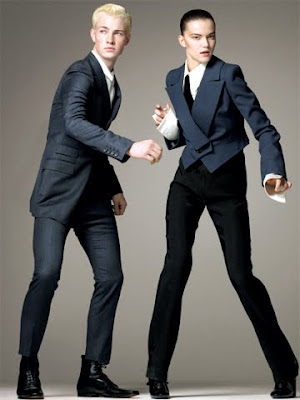
Varvara Stepanova, Russian gymnasium clothing, 1923
The naturalism argument against fashion is that the forms are constricting. From the high heel to the three piece suit, many aspects of the status quo are imposing. One reaction is fitness clothing which has made its way into fashion.

Bruce Weber for V Magazine, 41
Many feminists argue that fashion emphasizes youth and sexuality. The use of men’s clothing and the increase of unisex clothing is evidence of this consciousness.
Terry Tsiolis for V magazine, Fall 2007
Conservative skepticism suggests that indulging in fashion is an over-estimation of the times. The fashion industry is seen as a propaganda machine that positions basic clothing as “out of fashion.” Minority groups such as Hassidic Jews and the Amish, maintain their dress out of devotion and are not engaged in fashion. Dress is a distinguishing factor like law or language.
However the Afro and Mexican Zoot suit are examples of minority style factors that have worked their way into fashion. There are also fashion styles considered actively counterculture. The beatniks, hippies and punks consciously dressed in forms that opposed the status quo. Now many of those forms have been appropriated by designers like Gautier, Moschino or Vivenne Westwood who have made them more common and acceptable.

Mario Testino, Vogue Paris, November 2008






